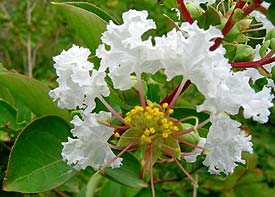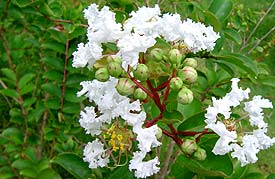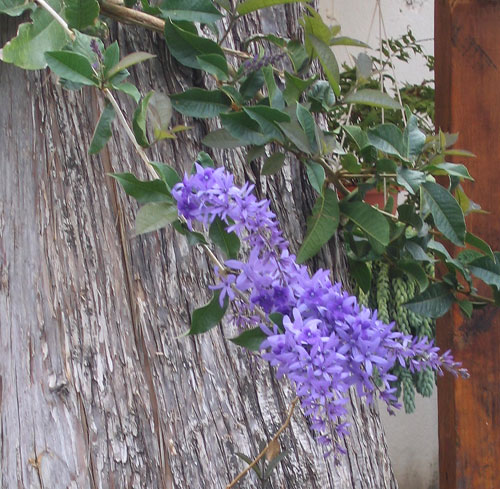Click below to see our plants alphabetically listed by common name with their cures and cooking ideas
|
A B C D E F G H I J K L M N O P Q R S T U V W X Y Z
Click for a list of my Special Pages
|
|
Search for Latin names and more here!
|
|
|

|
|
QUEENS
CRAPE MYRTLE AND CRAPE MYRTLE |
 **Crape
Myrtle, Crepe Myrtle Lagerstroemia indica **Crape
Myrtle, Crepe Myrtle Lagerstroemia indica
With
its dark green leaves the flowers on this small
normally fifteen foot tall tree or shrub really
stand out. It requires full sun to flower most
abundantly with its delicate, frilly, light purple/lavender
or white blossoms, but it will also flower in a
bright semi-shady area.
Benefits: Crape Myrtle has medicinal
applications and its wood is said to be useful as
well.
From: Originating
in South East Asia and Northern Australia, crape myrtle is now widely spread
around the globe.
Photographed: At
our former home in Montserrat unless otherwise noted.
Planting and Care: In the gardens at our former home in Montserrat,
we had good luck with our crape myrtles planted in a sunny area where they normally
bloomed for months on end beginning sometime in June. We then planted them as
part of a hedge in full shade and after several months they are finally began
thrive; they are even flowered. I read somewhere that providing lots of moisture
to young plants greatly speeds their growth and it's true based on what we've
seen; older established plants do just fine with whatever rainfall comes their
way. To stimulate production of new flower stems, cut off the old ones; it not
only works to bring more flowers, but the bush itself seems enhanced.
Text & Photographs Copyrighted ©Krika.com
2008/2010 and ©GreenGardeningCookingCuring.com
2018 |
  |
 Queens
Flower Tree, Queens Crape Myrtle, Queens Flower, Pride
of India, Banaba Lagerstroemia speciosa,
Lagerstroemia flos reginae Queens
Flower Tree, Queens Crape Myrtle, Queens Flower, Pride
of India, Banaba Lagerstroemia speciosa,
Lagerstroemia flos reginae
This too is really a crape myrtle, but may be
another variety. The ones we had on our property
in Montserrat never gave an indication that they
would grow into small trees, but that may be because
I pruned them frequently. As a small tree, growing
only to be about twenty feet tall, it is so beautiful
that when I saw it while driving to a friend's house
in Montserrat I just stopped the car and took the
picture below on the right. The owner's of the property
where it was photographed have two extremely vicious
dogs free to roam the neighborhood and attack at
will. I had only a moment to take the picture and
close the car window before they reached and leaped
at the car snarling and snapping their jaws.
Benefits: The leaves and roots are
said to have medicinal benefits which may include treatments
for stomach problems. By some it is said to be used
as a natural treatment for diabetes and by the ever
hopeful as an enhancement to weight loss.
From: India
Photographed: On
the right in the Royal Botanic Garden in Sydney, Australia, in 2013. Below
on the left at the Hotel Atitlan on Lake Atitlan in Guatemala in
2010 and on the right on
the Caribbean island of Montserrat in 2009. Below
those in
the Jardin Botanique in Tahiti in 2013
Planting
and Care: Full sun and routinely receiving a moderate
amount of water will keep the queens flower healthy for years
and in bloom for more than a few months every summer. It is
considered sub tropical and can handle temperatures in the
30's F. on occasion.
Text and Photographs Copyrighted ©Krika.com
2009/2010 and ©GreenGardeningCookingCuring.com 2013/2018 |
  |
  |
|
Queensland
Umbrella Tree, Schefflera,
Umbrella Tree, Octopus Tree Schefflera
Actinophylla
Planted in a tropical or non-freezing environment the umbrella
tree will excel, growing to be about twenty five feet tall and
spreading about half as much. This is one very tough and attractive
small tree; it is used as potted indoor greenery in many northern
climate office buildings and as a house plant by many northerly
gardening enthusiasts, but it only achieves its true self planted
outside in the sun.
Benefits: This small tree has been a part of traditional
medicine for a very long time with its stem, leaves and roots all
finding themselves useful in healing.
From: Australia, Java and New Guinea
Photographed: I don't have one as yet, but I'm working on it.
Planting and care: The umbrella tree will handle a shady
spot, but much prefers to be planted in the sun. It likes good soil and good
drainage
to
be
at its best and it is tropical in nature.
Text Copyrighted ©KO 2008 and ©GreenGardeningCookingCuring.com
2018 |
  **Queen's
Wreath, Petrea, Sandpaper Vine, Purple Wreath, Blue Bird
Vine, Fleur de Dieu Petrea volubilis syn. Petrea
kohautiana **Queen's
Wreath, Petrea, Sandpaper Vine, Purple Wreath, Blue Bird
Vine, Fleur de Dieu Petrea volubilis syn. Petrea
kohautiana
This is the vine-like bush that lived under and in and around the branches of
our red flamboyant tree in Montserrat. The papery leaves are pretty and its long
sprays
of
blue flowers are really lovely.
Benefits: It is known to have been used medicinally, but I don't
know
for what disorders.
From: It originated in the West Indies and the Tropical Americas.
Photographed: At our former home in Montserrat
unless
otherwise noted.
Pruning: Petrea will take very well to a hard pruning as we
discovered one year. One of ours had grown completely out of control and had
attached itself in an unattractive way to our bamboo. I cut it back severely
and in short order it was bushy and beautiful. I would recommend doing this sometime
during
rainy season or at a time when you will be watering.
Landscape architecture: Petrea is a wonderful tropical cousin
to the appearance of a wisteria vine in the north. It can be trained to a trellis
in much the same way although sadly its similar flowers don't have any noticeable
scent.
Text & Photographs ©KO 2008/2009
and ©GreenGardeningCookingCuring 2013/2015/2018 |
 Photographed: In
the garden of our former home Photographed: In
the garden of our former home
at Lake Atitlan in Guatemala in 2015. |
  Photographed: In
the garden overlooking Lake Atitlan at the Hotel Atitlan
in Panajachel, Solala, Guatemala. Photographed: In
the garden overlooking Lake Atitlan at the Hotel Atitlan
in Panajachel, Solala, Guatemala. |
| |
© 2019 GreenGardeningCookingCuring.com. All rights reserved
|

 **
**







 Photographed: In
the garden of our former home
Photographed: In
the garden of our former home 
 Photographed: In
the garden overlooking Lake Atitlan at the Hotel Atitlan
in Panajachel, Solala, Guatemala.
Photographed: In
the garden overlooking Lake Atitlan at the Hotel Atitlan
in Panajachel, Solala, Guatemala.